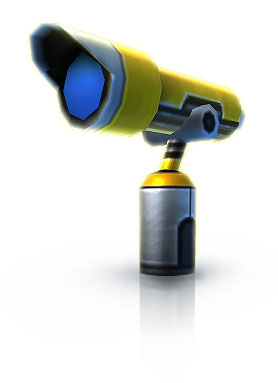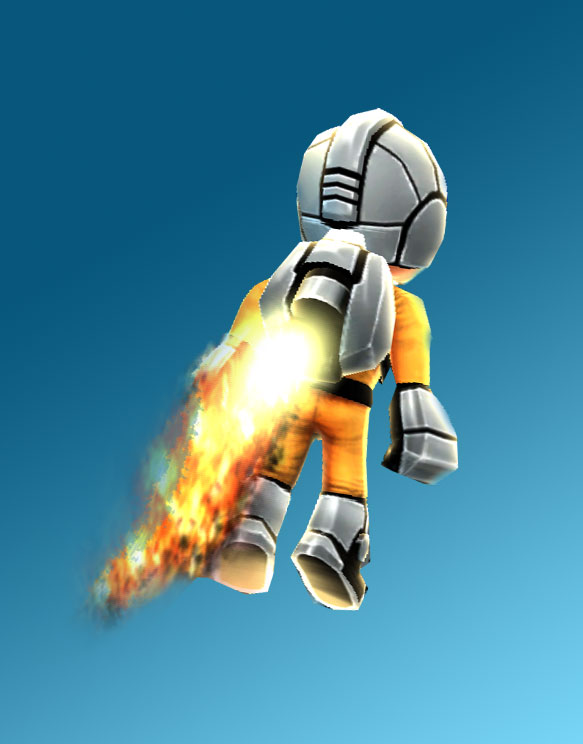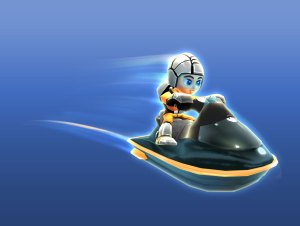Welcome to “Making of Jett Rocket”, part two. This time we will go into detail about some of the actual game design decisions. We will pick out a few sections that define the heart and soul of “Jett Rocket”.

Where To Go?
When we decided to do a 3D jump’n’run we had to choose what overall experience we wanted to deliver. When we play games ourself we enjoy to explore large worlds, though on the other side it’s a bad thing when you feel lost and have no clue where to go first. So we decided to break down the areas into smaller, self contained levels with a clear goal and a number of sub goals. The gameplay itself should focus on exploration, puzzle solving and collecting stuff that allows you to progress into more advanced areas. And all that glued together with some intense action gameplay.

The Perfect Camera
The levels should feel non-linear with different paths to explore and only with minimum camera scripting. That meant we needed an intelligent camera system that tries to detect what the player wants to do and where we wants to go next. The player should be able to adjust the camera but he shouldn’t be forced to. Although this is a classic problem in game development it is still very hard to solve. And only few games did a good job at that topic. Fortunately, after a lot work, we were quite happy how our camera system turned out.

On The Jet Stream
After setting up the general gameplay constants we concentrated on “Jett Rocket” himself. We wanted him to do the standard variety of jump’n’run moves but he should also have something special. Quickly we had the idea to give him a jet pack. After some testing we knew that it was a good idea. This immediately gave the game a character of its own and dramatically changed how levels needed to be directed. With the jet pack you can go to many places you wouldn’t be able to get otherwise. By spreading ‘fuel’ stations across the levels we were able to give hints to the player without really telling him too much. We also added some motion controls to refill the jetpack which turned out to be great fun. Those controls were perfectly intuitive without having the feeling to waggle for nothing.

Massive Attack
All in all “Jett Rocket” can perform around 20 different moves and attacks. A third of the moves were already available when we started with the first level. The rest came in when we had a great idea or when something new was needed to keep the player interested. Especially adding vehicles to the game was pretty fun for us and gave the players something new to experiment with. The vehicles are not just decoration, you really need them to solve the levels.
Here are some of Mr. Rocket’s abilities:
Fly with the jet pack, Ride a Jet Boat, Dash Ground Attack, Glide with a parachute, Dash Air Attack, Drive a Snow Mobile, Hang on, Turn cranks, Pump up fuel, Pickup Items, Throw Items, Get Hit, Talk, Slide, Fall, Walk, Run, Jump, Swim

60fps or 30fps?
Many nice games on the Wii are running in 30 frames per second (fps). Often people don’t even immediately notice a difference to 60 fps games. Developing for 30 fps is easier as a developer has twice the power available for each frame. So it’s tempting to drop 60 fps support.
At Shin’en we love the super fluent look of a 60 fps title. Also controls are tighter on 60 fps than on 30 fps. Some may now argue that 30fps means you could have better graphics. Well, we remember that we could draw around 2000 triangles per frame on the Nintendo DS. Although that was a limit it wasn’t a problem to make games like “Nanostray 2” look absolutely gorgeous. On the Wii we can easily show 50 times as much polygons , plus we have stunning shaders. So if we couldn’t deliver nice graphics with that many polygons and all that shader magic then we would do something wrong.
After all the best rated Wii titles use 60 fps (Metroid Prime series, Wii Sports Resort, Super Mario Galaxy, Mario Kart, etc). Although may not be immediately noticed, we believe that 60 fps deliver a better overall performance for a game. That was reason enough for us to take the extra challenge and develop “Jett Rocket” in rock solid 60 fps.
We hope you enjoyed the picks from our daily development grind. Next time we will talk about the “Jett Rocket” universe, the actual level design and how tiny lighting makes a big difference. Stay tuned!




















